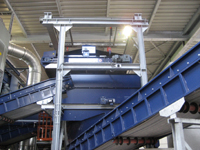Iron and non-ferro metals separated from buiding and demolition waste The recently started joint venture between the Dutch firm Goudsmit Magnetic Systems B.V. of Waalre and Waltec Practical Waste Solutions B.V. of Gees, with Vliko B.V. of Leiderdorp as the end processor, provides for the complete removal of iron particles from building and demolition waste (BDW). Due to the deep and strong capture field of the electro overhead separator magnets for conveyor belts, the coarser fractions are made iron-free more effectively than with the use of permanent overhead magnets. This refers mainly to waste fractions of 400 mm and greater. At a later state, all non-ferro metals such as aluminium, copper and brass are removed from this building and demolition waste. At IFAT the firm from Waalre presented, among other things, its magnetic systems and non-ferro separators.
The electro overhead separator magnets on show there are stronger than the previous ones due to a deeper capture field. These magnets are highly suitable for removing of iron particles from recycling and/or bulk handling flows such as household waste, RDF (Refuse Derived Fuel), incineration cinders, recycled glass and rubber, coal, cement, asphalt; materials that are increasingly re-used and/or used for generating energy. The conveyor belts are extra strong and wear-resistant so that they can capture and subsequently dispose of the separated iron particles without any difficulty. An auxiliary magnet provides for the removal of the iron particles from the magnetic field.
Over the last 15 years a totally new market has been created for both electro and for permanent overhead separator magnets for conveyor belts. This is due in particular to the tighter environmental standards introduced in Europe. High dumping costs for waste and the ban on dumping waste is forcing the industry to reduce waste flows. To this end, a magnet is a relatively simply and inexpensive separation system. Hundreds of tonnes of re-usable steel will be separated from various waste flows by means of permanent magnets or electro magnets. With the current metal prices, this means that a lot of money will be earned back. 30/04/2008 |